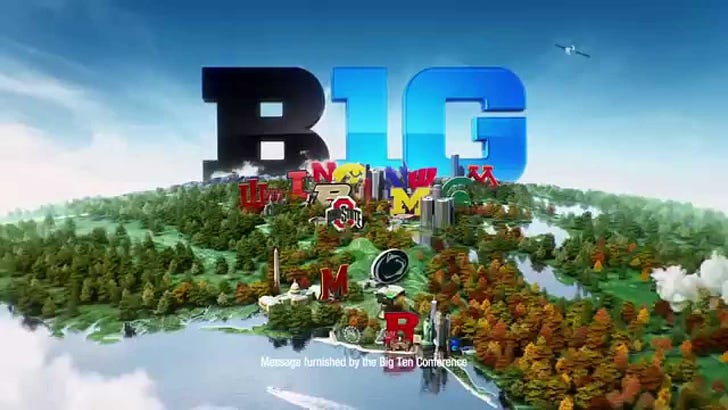The Big Ten’s “Maps” commercial is an institution. Since its debut in 2014, this meticulously crafted, masterfully animated, and impeccably soundtracked spot has graced millions of screens thousands of times. Experiencing it has become as much a part of Big Ten sports as singing our fight songs or watching all of our teams lose in the first weekend of the NCAA Tournament. If Big Ten country had a national anthem, it would be “Silver Lining” by Guards.
The year the commercial debuted—the year Maryland and Rutgers joined the league—was my senior year of high school. I didn't really get into college sports until middle school, so my memories of the Big Ten to that point were pretty minimal; it was basically just Bo Pelini losing a bunch of key games and that one time E’Twaun Moore went supernova against Ohio State. Despite growing up on the outskirts of Big Ten country (Sioux Falls), I was hardly familiar with the Big Ten of old.1
So this obvious cash-grab move—adding schools from the New York and Washington markets to what was ostensibly the “Midwest conference”—couldn't really bother me that much aside from just on principle.
When I applied to universities, I knew that I wanted to get out of South Dakota but stay in the general area, preferably at a big school where I could get a fresh start. I only applied to two schools, both of them in the Big Ten: Nebraska and Minnesota. I initially picked Nebraska, but after one semester in Lincoln, I changed my mind and finished my degree in Minneapolis.
As one does, one of the first things I did after I moved into my Minnesota dorm was hit the bookstore. While making the mistake of spending way too much on textbooks I never read, I also sought decor for my room. Along with a probably ridiculous volume of sports posters, maps took up most of my wall space when I was growing up. They continued to mean a lot to me as a young adult, as I had decided to major in geography and begin learning how to make them professionally.
So imagine my delight when I found a map that was also a sports poster. “Maps” was already such a big hit that the conference had turned it into an actual, physical map. I still have it framed on my wall today.
With “Maps” playing continually on TV for the next several years and its laminated paper counterpart blessing my wall interminably, the Big Ten it represented became the Big Ten I know and love. I attended nearly every men's basketball game from my sophomore through senior years, becoming a fixture of our student section, the Barnyard. I even appeared in a different Big Ten commercial in the process. See if you can find me.
In 2019, I became a Big Ten alum and left for North Carolina. As I earned my graduate degree in the ACC (whose commercials aren't nearly as good), the map on my wall and the commercial on my TV served as a constant reminder that the comfort of home was still there for me to reclaim whenever I was ready.
There was also that two-year stretch when the league lost the licensing rights to “Silver Lining” and replaced it with a less fitting song, and we don't talk about that. But during that period came the announcement that the map would have to change: in August 2022, the Big Ten announced that UCLA and USC would join the conference beginning in 2024-25.
In high school, I had no frame of reference for how to feel when Maryland and Rutgers joined. One diploma and two degrees later, reading this announcement filled me with an immediate sense of disgust. I’m not here to wax poetic about all of the reasons why—you’re already well aware, and plenty of folks have already done that much better than I ever could—but the move away from regional rivalries and toward a twisted, bootleg, national minor league put a pit in my stomach the size of the Grand Canyon that separates all current league members from the two new ones.
I followed my heart back to Minnesota in May 2023. Three months later, the Big Ten admitted Oregon and Washington, ballooning its impending membership to 18. Around the same time, “Maps” returned to its former glory, as the league listened to the unsilenceable cries of its fans and reacquired the rights to “Silver Lining”.
It’s been a joy to once again experience this work of art as it was originally intended, but I can’t deny that it always comes with a forlorn aftertaste. It’s odd, really. I know the landscape of college athletics is shifting in seismic fashion once this season draws to a close, but that has always become easy to ignore in the heat of watching the games. Only from viewing “Maps” do I receive regular reminders of what we’re about to lose.
As I’ve watched the Big Ten Tournament this week, it’s finally sunk in that this is really the end. Obviously, on a broad scale, it’s the end of an era for college athletics. But more specifically to me, the Big Ten that I fell in love with—the one that left me so many core memories as a student and recent grad—is becoming a thing of the past. We’re folding the map and putting it in the archives to be replaced with a newer edition.
“I wanna live forever; I don’t care.”
These are the lyrics famously echoed by Guards frontman Richie Follin as “Maps” zooms out to display the entire league. At the commercial’s peak, this refrain was a triumph—a perfect encapsulation of the attitude us Big Ten fans had toward this conference.
Today, the comedown hits. We can’t live forever. It was always bound to end.
I definitely wasn’t familiar with the ACC of old, so I had no idea how much ACC fans hated Maryland’s departure until years later.





